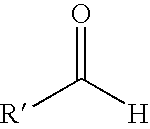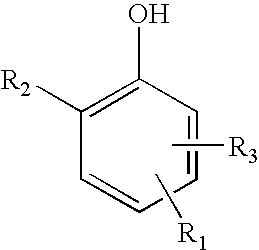Process for preparation of Mannich condensation products useful as sequestering agents
a technology of sequestering agent and condensation product, which is applied in the preparation of amino compounds, fuels, organic chemistry, etc., can solve the problems of acid catalytic reaction and rearrangement of oil, wear and corrosion, and impair the efficiency of these elements, so as to prevent metal ion catalytic oxidation and polymerization reactions, and sufficient oil solubility
- Summary
- Abstract
- Description
- Claims
- Application Information
AI Technical Summary
Benefits of technology
Problems solved by technology
Method used
Image
Examples
example 1
Preparation of Mannich Condensation Product Using 1,000 Molecular Weight Polyisobutyl-substituted Phenol
[0179]
[0180]In a one liter round-bottom flask was added 351.09 grams (0.23 moles) of 1,000 molecular weight polyisobutyl substituted phenol as defined in the Definitions section. The polyisobutyl-substituted phenol used in this Example and in the following Examples in the present patent application was prepared as described in U.S. Pat. Nos. 5,300,701 and 6,274,777. The polyisobutyl-substituted phenol, diluted in 31 percent Chevron® 100N, neutral oil (hydroxyl number=36.77 milligram KOH per gram sample) was combined with 2.88 grams (0.036 moles) aqueous sodium hydroxide (Aldrich® 50% solution). The mixture was stirred and heated at about 35° C. under nitrogen. After approximately 15 minutes, when the mixture was homogenized, 14.99 grams (0.46 moles) paraformaldehyde (Celanese® prills 92.56%) was added to the reaction flask. Temperature of the reaction mixture was increased to abou...
example 2
Preparation of Mannich Condensation Product Using 1,000 Molecular Weight Polyisobutyl-substituted Phenol
[0184]Mannich condensation product was prepared in a 4 liter reactor.
[0185]
[0186]To a 4 liter reactor equipped with a temperature probe, an overhead system and a mechanical stirrer was added 2,500.5 grams (1.638 moles) of 1,000 molecular weight polyisobutyl-substituted phenol. The polyisobutyl-substituted phenol was diluted 31% in Chevron® 100N, neutral oil (hydroxyl number=36.77 milligram KOH per gram sample) and heated to 80° C. When the temperature of the contents of the reactor had reached 80° C., 13.2 grams (0.164 moles) sodium hydroxide solution (Aldrich® 49.4% aqueous solution) was added to the reactor, followed quickly with the addition of 109.7 grams (3.277 moles) paraformaldehyde (Celanese® prills 92.56%). The reaction mixture was maintained at a temperature between about 80° C. to about 90° C. for 1.5 hours. A 1H NMR was taken on a sample at this point in the reaction. ...
PUM
| Property | Measurement | Unit |
|---|---|---|
| weight percent | aaaaa | aaaaa |
| temperature | aaaaa | aaaaa |
| temperature | aaaaa | aaaaa |
Abstract
Description
Claims
Application Information
 Login to View More
Login to View More - R&D
- Intellectual Property
- Life Sciences
- Materials
- Tech Scout
- Unparalleled Data Quality
- Higher Quality Content
- 60% Fewer Hallucinations
Browse by: Latest US Patents, China's latest patents, Technical Efficacy Thesaurus, Application Domain, Technology Topic, Popular Technical Reports.
© 2025 PatSnap. All rights reserved.Legal|Privacy policy|Modern Slavery Act Transparency Statement|Sitemap|About US| Contact US: help@patsnap.com



